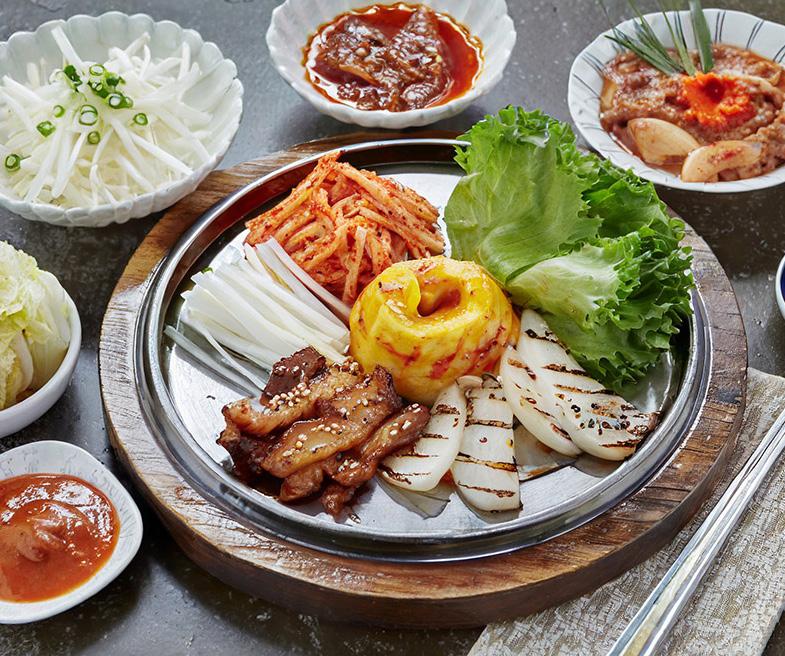
4 minute read
Sweet & Savory
Korean BBQ Hallyu
By Nina Jobst
Last updated: September 28, 2023 • Original Source Cited: Statista • Article has been edited for this format
Known as Hallyu, is the global phenomenon around Korean culture that’s been on the rise since the start of the 21st century. Particularly in the food segment, consumers across the globe are becoming increasingly drawn to Korean BBQ restaurants.
With the added element of pop culture influence, the demand for Korean BBQ in general will also likely continue to increase. Based on recent data indicating that Korean culture, with an emphasis on cuisine, is continuing to spark appeal on an international scale, Korean flavors are especially worth keeping an eye on.
Traditionally Korean cuisine consists largely of rice, vegetables, seafood, and meat. It is especially well-known for offering a large variety of side dishes (banchan) to eat along with the main course. Because of its composition, Korean food is widely perceived as healthy. Besides being a traditional cuisine, convenience and trend foods have also become a strong force in the growing South Korean food market.
Given this data, restaurants are taking note of the widespread popularity among consumers and integrating Korean-inspired items to its menus. Other restaurants have tailored the entirety of its menus to Korean cuisine, creating products that hone in on Korean culture in an effort to drive increased customer appeal.
Korean cuisine is also spreading its influence to the western world through the diversity of spices offered. As spicy dishes continue trending across social media platforms, westerners are increasingly interested in Korean cuisine because of the spice elements incorporated in many of the traditional dishes.
DOMESTIC PRODUCTION AND EXPORTS
The popularity of Korean food worldwide has led to increased demand, be it for items in supermarkets and e-commerce platforms or Korean restaurants abroad. The domestic food production in South Korea grew to match this, and exports followed suit. However, the expanding reach of Korean food culture did not stop at international trade. Instead, leading food companies like Nongshim started to operate food production establishments overseas, and CJ CheilJedang’s brand Bibigo opened branded restaurants in other countries.
WHICH KOREAN FOODS ARE POPULAR OVERSEAS?
With rising awareness, popularity, and accessibility, the share of people who tried Korean cuisine globally naturally increased, with more than three in four respondents in a survey stating to have eaten it. With more people becoming acquainted with Korean food, more food products made their way onto the global market. As for popular products, foods and beverages promoted or consumed by celebrities were well-liked by fans, and managed to increase the popularity of a brand or item. This was not only true domestically but also internationally. Moreover, food that frequently appeared in dramas or other TV shows attracted even more attention. This includes Korean Barbeque, Korean-style fried chicken – which was also chosen as the most preferred Korean food overseas – and street food such as Tteokbokki (spicy rice cakes).
KOREAN FOOD ONLINE TRENDS
Through the internet, viral social media challenges can spread far and wide, and of course, Korean food is no exception. The number of online videos about Korean food increased, be it traditional food recipes or trend videos with new ideas or more modern twists, like vegan recipes. Mukbang videos have been around since 2009 in South Korea when they started being broadcasted on AfreecaTV. In these videos, the host would eat a meal while conversing with the audience via streaming to give a feeling of eating together. In recent years, the term mukbang videos are also associated with eating unusually large amounts or combinations of food, going so far as to become a challenge of sorts. One of these viral challenges included eating

Korean spicy instant noodles (ramyeon). Such products have gained a certain notoriety thanks to this, and became sought after even in countries that were not accustomed to Asian-style instant noodles. Another recent trend was the infatuation with Dalgona, a traditional snack made from sugar that had appeared in the Korean Netflix hit series Squid Game. Dalgona coffee, a time-consuming method to make sweet coffee at home which emerged during the COVID-19 pandemic, also quickly spread throughout social media as a novel recipe.











